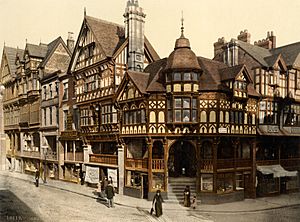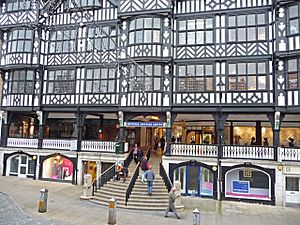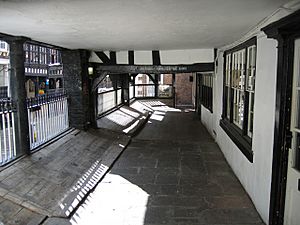Chester Rows facts for kids
The Chester Rows are unique covered walkways found in the city of Chester, United Kingdom. They are built on the first floor of buildings along the city's four main streets. These walkways have entrances to shops and other places. At street level, there are also many shops, often reached by going down a few steps.
The Rows date back to the Middle Ages. People are not sure exactly how they started. Some think they were built on top of old Roman ruins. Today, the Rows are a major tourist attraction in Chester. Many buildings that are part of the Rows are listed, meaning they are historically important.
Contents
What are the Chester Rows?
The Chester Rows are special because they have two levels of shops. At street level, you'll find shops like in any other town. But many of these shops are a bit lower than the street.
On the first floor, there's a continuous walkway set back from the street. This walkway is covered by the floor above it. This covered path is what people call a "Row." Along the street side of the walkways, there are railings. This area was once used to display goods for sale.
The Rows are found in the streets leading from Chester Cross. These include Watergate Street, Northgate Street, Eastgate Street, and Upper Bridge Street. They are mostly continuous on both sides of Upper Bridge Street. You can also find them along most of Watergate and Eastgate Street.
Below the street level shops, there are often stone rooms called "undercrofts" or "crypts." These rooms are usually half a storey below the street.
How Did the Rows Start?
The Rows were built in the four main streets of Chester. These streets have been important since Roman times. The main Roman road went from east to west (now Watergate Street and Eastgate Street). Later, a road from the south (Bridge Street) and one to the north (Northgate Street) were added.
Evidence shows that the Rows existed as early as the 13th century. The first clear mention of an elevated walkway like the Rows was in 1356.
Because the Chester Rows are so unique, people have many ideas about how they began. Chester had several big fires in the past. In 1278, a fire destroyed almost the whole town. Some believe that after this fire, owners were told to make their ground floors fireproof. This might have led to the stone undercrofts. People then might have added the two-level access to make shopping easier.
Another idea connects the Rows to the debris left by the Romans. When Roman buildings fell apart, their rubble piled up along the streets. It's thought that in the Middle Ages, new buildings were built on top of this rubble. These buildings were set back from the street. A path ran in front of them, while carts used the street below. Over time, people improved these buildings. They dug out cellars or undercrofts in the rubble. Later, upper floors were added that hung over the lower storey. This created the covered walkways we see today. Stalls were added for displaying goods, and so the system of the Rows grew. By about 1350, most of the Rows were built.
The Rows in Medieval Times
During the Middle Ages, the Rows were used for homes as well as shops. The main door often led into a hall that was at a right angle to the street. Sometimes, the front part of the hall was a shop. Other times, the whole hall was used as a shop.
Above the hall was a room called a "solar." This was a private living space for the family. Below the Rows, at street level, were the stone undercrofts or crypts. These often had arched ceilings. They were used for storage or for selling valuable items. Behind the main hall, on the Row level, were more living areas. The kitchen was usually a separate building in the backyard.
The Rows Today
Today, about 20 stone undercrofts still exist. Many of these date from the 13th or early 14th century. One famous example is Cowper House at 12 Bridge Street. It has a large undercroft with six sections. Another is at 15 Bridge Street. The Falcon in Lower Bridge Street also has an undercroft.
At the Row level, most medieval buildings were made of timber. Not many original timber parts remain. One important exception is the building called Three Old Arches. It has three stone arches at the front. This is likely the oldest known shopfront in England. This building also has its original undercroft and hall.
Many buildings that include parts of the Chester Rows are listed. This means they are protected because of their historical importance. Most of the places on the Rows are shops. But you can also find offices, restaurants, cafes, and meeting rooms. For example, 1 Bridge Street has shops on both the street and Row levels. Crypt Chambers has a department store. Bishop Lloyd's House has a shop and meeting rooms.
Since 1995, it's been easier to visit the Rows. Most vehicles are not allowed in the area during the day. This makes it safer and more pleasant for people walking and shopping. The Chester Rows are a very popular place for tourists. People love their unique look and the covered shopping experience they offer.
In 2010, the Chester Rows were considered for World Heritage Site status. This would recognize them as a place of outstanding global importance.
See also
 In Spanish: The Rows para niños
In Spanish: The Rows para niños





